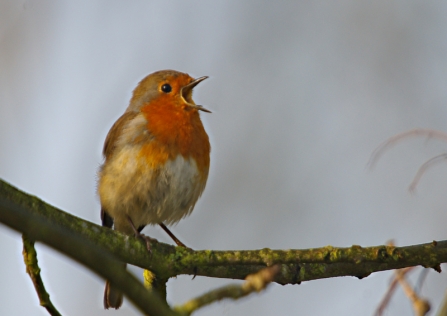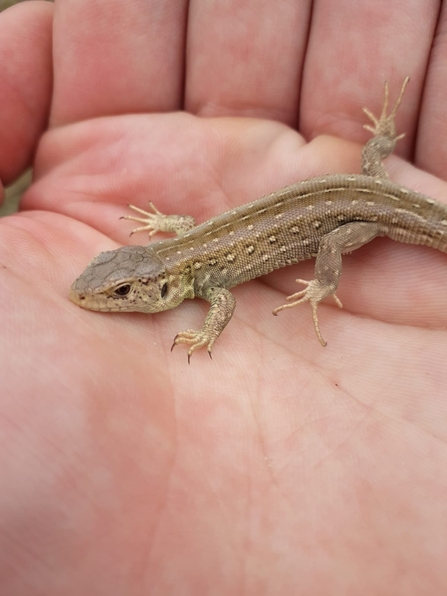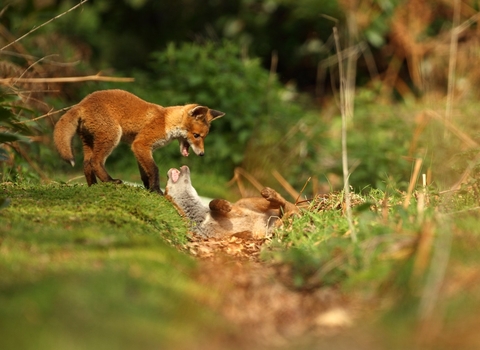Perhaps the biggest took place in my old stomping ground of Greater Manchester. We all know those moments when we feel like bursting into tears – of sheer joy or relief. For me, that usually involves standing in the middle of muddy festival after taking hours to put up my tent in the rain, and suddenly a band plays a song I’d only heard on CD. This year, my teary moment came on Astley Moss when we released the Manchester Argus butterfly there for the first time in 150 years.
Our 2020 highlights: a year of saving wildlife

The moment a large heath butterfly is released onto the Manchester mosses. Photo by Dr Luke Blazejewski.
This landmark release was part of our ongoing Great Manchester Wetlands Species Reintroduction Project, which aims to return locally extinct species of plants and animals to areas where they were driven out by peat extraction and development.
The Manchester argus reintroduction was a long process from just an idea from our conservationists, to taking female insects from Winmarleigh Moss to Chester Zoo, where the caterpillars were raised, and then praying it would all go well on release day at Astley Moss. Add to that the fact that most of my childhood was played out around Astley, so there was quite a bit of emotion ready to pour out.
Thankfully the release played out without a hitch. The weather was perfect, Chester Zoo were able to broadcast it live on their Facebook page, and watching these delicate insects fluttering around the fluffy cottongrass was a joy.

Joy is something we’ve all had to cling onto this year. If someone told me at Christmas 2019 that many of us would be locked in our homes for months, I would have said it was a tale of science-fiction. We all had to adapt to unsettling new circumstances, but thankfully, Lancashire Wildlife Trust was on-hand to help. Our team did an incredible job of bringing wildlife to the masses; helping people stay connected to the natural world despite the circumstances, and sharing heart-warming stories that illustrated how wildlife was flourishing. In return, we heard your stories, too – it was wonderful to see you all feeling closer to your local birds, roe deer, voles and weasels.
This year, thanks to the amazing Josh Styles, I have spent much more time looking at plants. We discovered gold at Winmarleigh Moss: golden bog moss, to be exact. The thing that excites me most is that finding these plants on this rare landscape, where they haven’t been recorded for a century, means insects, that have also been missing, are returning too.
And that inevitably means birds and mammals will return to these landscapes. In fact, they already are. Nightjars were recorded on Manchester’s mosses this summer for the first time in 20 years. I have only ever heard stories of this once-common bird, so to know it’s back, and I could finally hear its eerie churring in person, is overwhelming.

Young sand lizard
There was also a great moment on the Fylde Dunes when, along with the Amphibian and Reptile Group and Fylde Council, we released sand lizards for the third year running. You are unlikely to see these amazing creatures but they are back where they belong.
It’s brilliant to see so much wildlife returning to our region with the help of our conservation teams, especially when nature is so beneficial to our mental health. Our Nearby Nature report is testament to just how much people in Lancashire, Manchester and North Merseyside have really benefitted from our wild plants and creatures this year, perhaps more than ever.
A lot of people have asked me: “Is the dawn chorus louder this year?” While it’s true that our robins, thrushes and blackbirds are singing without the competition of noisy traffic as drivers stay off the roads, it’s more likely that we’re simply noticing birdsong more as we enjoy our gardens or walk in local woods. And as well as improving our wellbeing, if everyone is noticing wildlife, they’re more likely to want to help us protect our wild things.
And that is certainly a highlight of 2020: the start of many beautiful friendships with nature for generations to come.


